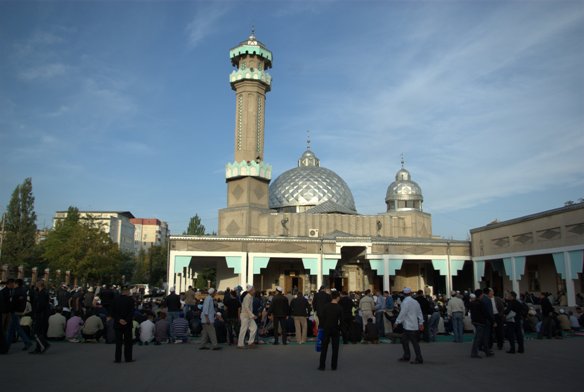
HISTORICAL AND POLITICAL CONTEXT
Literally translated, “Kyrgyzstan” means “Land of the Forty Tribes.” The region’s story re-flects this meaning as the area has been subject to occupation by the Ottomans, Muhammad Ali Khan, the Khan of Kokand, accession to the Russian Empire, and the Soviet Union. Following the gradual adoption of Islam during the Kokand regime, tribal wars and fratricide plagued the land, which after several tribes submitted to Russian control, becoming part of the Russian Empire. After being part of the Soviet Union, Kyrgyzstan finally declared its independence on August 31, 1991. Because of its tumultuous location, various ethnicities comprise modern-day Kyrgyzstan: the ethnic Kyrgyz comprise 72% of the population, and Uzbeks, Russians, Dun-gans (an ethnic group related to the Hui people of China, professing Islam), and other minority groups comprise the remaining 28%. Kyrgyzstan has languages: state Kyrgyz and official Rus-sian, with no official state religion.
Since its independence, Kyrgyzstan has undergone several threats to its parliamentary de-mocracy: In 2005 and 2010, the Kyrgyz people rebelled in order to oust both the first and sec-ond presidents for reasons of high corruption in the country and tribalism, and refused to leave office after terms had expired. In response to these threats, Kyrgyzstan adopted a new constitution in 2010 that stripped the president of many powers and transferred them to the Government and the Jogorku Kenesh. This transfer was intended to prevent the political dominance of any one party and better ensure rule of law and the protection of human rights. In contrast to previous presidents, Kyrgyzstan’s third president voluntarily stepped down and a peaceful election ensued in 2017. But the legal status of the President is characterized, by the fact that he is the head of the state, which implies that he is the first among state officials, and the only one being elected in national elections.
RELIGIOUS CONTEXT
Though Kyrgyzstan was strongly influenced by Communism, after the fall of the Soviet Union, Kyrgyzstan embraced its earlier Turko-Persian heritage and the Islamic faith associated with it. Because of its diverse religious and cultural heritage, however, Christian shamanist, and communist heritages still remain While Kyrgyzstan is constitutionally as secular state with no state religion, the government has stated that Sunni Islam and Russian Orthodox are “traditional Religious groups.” The Protestant denominations of Christianity have existed for a long in the territory of Kyrgyzstan (the first, Baptists and German Mennonites, invited to Russia by Catherine the Great, arrived in Kyrgyzstan in 1897). While the Kyrgyz government appears to continually support its role as a secular state, Kyrgyzstan’s predominantly Muslim population does influence both government action and day to day living.
Reports on Kyrgyz religious freedom suggest that freedom of belief and religion is constitu-tionally respected and guaranteed, but non-traditional religions frequently experience governmental restrictions and societal persecution. And even though the laws broadly protect freedom of association and assembly, recent laws severely disadvantage the creation and promulgation of new, non-traditional religious organizations. And even though the laws broadly protect freedom of association and assembly, recent laws severely disadvantage the creation and promulgation of new, non-traditional religious organizations. According to Pew’s study of Kyrgyzstan religious restrictions, Kyrgyzstan falls above the median score for social hostilities and government restrictions, but still well below countries like Russia and Syria. Overall, it appears that Kyrgyzstan, at least constitutionally, has some protections for religious liberties; but because of governmental and societal restrictions, those liberties are not widely afforded to new or non-traditional religious organizations and its members.
SOURCES OF LAW AFFECTING RELIGION
a. Constitutional Law
Kyrgyzstan is a secular democracy with no official religion. According to the constitution, freedoms of choice and possession of religious or other beliefs are inviolable rights that “shall not be subject to an [sic] limitation whatsoever.” The constitution further protects freedom of association and assembly. As recent laws limiting assembly and associational rights have been upheld in the Kyrgyz court system, it appears these rights may not apply to religious liberties, at least under the current interpretation of the constitution. These are not the only rights lacking full protection, however, as numerous reports complain of the justice system’s failure to prose-cute other constitutionally inviolable human rights that have been consistently violated.
b. Statutory Law
From 1991 to 2008, Kyrgyzstan liberally protected religious freedom. However, this changed drastically in 2009 when a newly-passed bill indirectly restricted new, foreign, non-traditional, or proselytizing religious organizations that could be considered a threat to “nation-al security, social stability, . . . public order, . . . or morality.” The Freedom of Conscience and Religious Organizations in the Kyrgyz Republic of December 31, 2008 (hereinafter 2009 Religion Law) declares inviolate a person’s rights to ascribe to and express any religious or atheistic beliefs, also declaring all religions equal before the law. The very next clause, however, allows the government to restrict any religious organization to “secur[e] rights and freedoms of other persons, social security, order, territorial integrity, and protection of the constitutional order.” Thus the law does not affect the beliefs of an individual or group of individu-als, but it severely limits the practice of certain religions, especially those that fall in the new, non-traditional, or proselytizing categories. As this is the leading law in Kyrgyzstan affecting religious freedom, this report next details the key provisions that affect religious freedom.